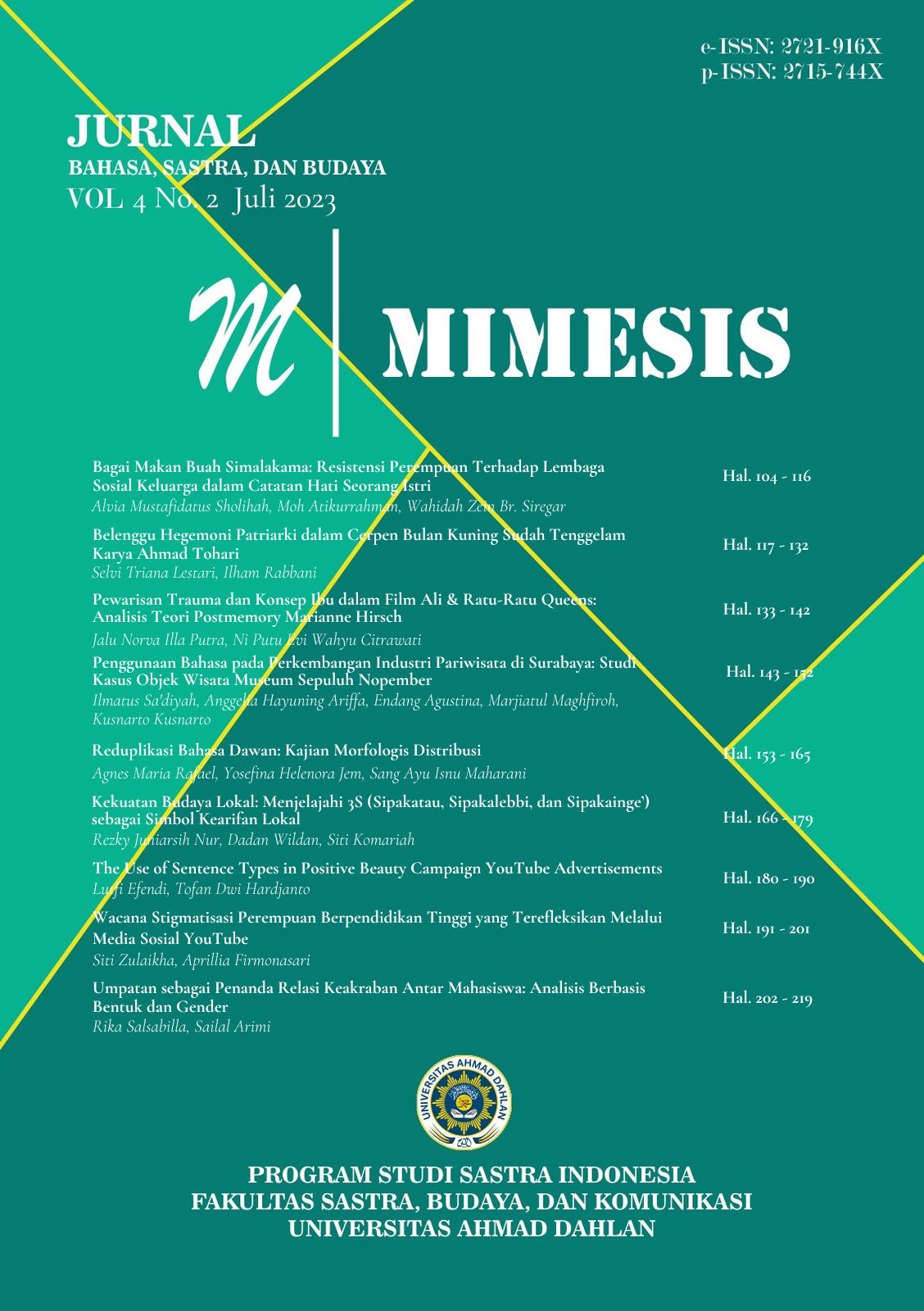Umpatan sebagai Penanda Relasi Keakraban Antar Mahasiswa: Analisis Berbasis Bentuk dan Gender
DOI:
https://doi.org/10.12928/mms.v4i2.8367Keywords:
Intimacy Relation, Language and Gender, Sociolinguistics, SwearingAbstract
Swear words using is considered low-value and inappropriate behavior in a normative society. There are differences between men and women in in the using of swear words. The purpose of this study was to identify the swearing lexicon along with the lingual forms and its references used by each gender. Also, to find out the frequency of its use and what factors trigger the use of swear words from each gender. Quantitative and qualitative approaches were used with data collection techniques through a questionnaire survey conducted on 115 students. The results of the study found that the choice of lexicon of swear words from the male gender is wider and more varied. Swearing is identified based on morphological and syntactic lingual forms. References of male gender come from groups of objects, animals, body parts, professions, situations, and activities. Meanwhile, references of female gender are more polite although they still seem rude, namely coming from groups of words such as animals, circumstances, activities, and objects. The frequency of use of both genders shows that the intensity of swear words using is rarely used.References
Affini, L. N. (2017). Analisis kata tabu dan klasifikasinya di lirik lagu Eminem pada album The Marshal Mathers LP. Lensa, 7(1), 93-113.
Anggraeni, A. (2019). Identitas gender dalam penggunaan kata-kata tabu bahasa Jawa di Jawa Timur. Deskripsi Bahasa, 2(1), 68-75.
Batubara, M. H., Ramayana, V., & Rahila, C. D. I. (2022). Analysis of youth language and taboo words in the gayo language. Journal of Linguistics, Literature, and Language Teaching (JLLLT), 2(1), 17-21.
Beers Fägersten, K., (2012). Who's swearing now? The social aspects of conversational swearing. Cambridge Scholars Publishing, Newcastle upon Tyne.
Jay, T., Janschewitz, K., (2008). The pragmatics of swearing. J. Politeness Res. Lang. Behav. Cult. 4 (2), 267-288.
Jensen, J. T. (2004). Principles of generative phonology. John Benjamins Publishing Co.
KBBI. (2023, Oktober). Kamus Besar Bahasa Indonesia (KBBI). Diakses pada Maret 25, 2023, dari https://kbbi.kemdikbud.go.id
Keraf, G. (1996). Linguistik bandingan historis. PT. Gramedia. Gramedia.
Kridalaksana, H. (2001). Kamus Linguistik. Gramedia Pustaka Utama
Marnetti, N. F. N. (2017). Majas sarkasme dalam penulisan komentar pada “wartawan senior bongkar kebusukan antasari, nasrudin dan permainan jahat pdip”. Suar betang, 12(1), 71-81.
Masykur, P. S. S. (2014). Bentuk dan fungsi umpatan oleh siswa sma negeri 2 majene, Sulawesi Barat dalam situasi nonformal. Skriptorium, 2, 63-75.
Muhanović, M., Babić, N., & Latić, E. (2018). An analysis of gender differences in the use of swear words on Facebook. Journal of Education and Humanities, 1(2), 89-98.
Nicolau, M. F. S., & Sukamto, K. E. (2014). Male and female attitudes towards swear words: A case study at binus international school. kata, 16(2), 71-76.
Poerwadarminta, W. J. S. (1939). Baoesastra Djawa. JB Wolters.
Rokhman, Fathur. (2013). Sosiolinguistik suatu pendekatan pembelajaran bahasa dalam masyarakat multikultural. Graha Ilmu.
Santoso, A., & Taufiqurrahman, F. (2023). Proses fonologis bahasa gaul generasi ‘z’di sosial media (analisis fonologi generatif). Jurnal Onoma: Pendidikan, Bahasa, dan Sastra, 9(1), 80-88.
Schane, Sanford A. (1973). Generative phonology. America: Prentice Hall College Div.
Setyaningrum, A., & Maryadi, M. A. (2020). Swear words used in" Suicide Squad" Movie: A Sociolinguistics Perspective (Doctoral dissertation, Universitas Muhammadiyah Surakarta).
Triadi, R. B. (2017). Penggunaan makian bahasa Indonesia pada media sosial (Kajian Sosiolinguistik). Jurnal Sasindo Unpan, 5(2), 1- 26.
Wijana, I. D. P. & Muhammad, R. (2006). Sosiolinguistik: Kajian teori dan analisis. Pustaka Pelajar.
Wijana, I., & Putu, D. (2004). Makian dalam Bahasa Indonesia: Studi tentang bentuk dan referensinya. Humaniora, 16(3), 242-251.
Wong, K. (2017, July 27). Nytimes.com. The New York Times - Breaking News, US News, World News and Videos. Diakses pada December 14, 2022, dari https://www.nytimes.com/2017/07/27/smarter-living/the-case-for-cursing.html
Yayuk, R. (2019). Klasifikasi tabu pada masyarakat banjar (taboo classification in banjar society). Kandai, 15(1), 27-46.
Downloads
Published
Issue
Section
License
Copyright (c) 2023 Rika Salsabilla, Sailal Arimi

This work is licensed under a Creative Commons Attribution-ShareAlike 4.0 International License.
License and Copyright Agreement
In submitting the manuscript to the journal, the authors certify that:
- They are authorized by their co-authors to enter into these arrangements.
- The work described has not been formally published before, except in the form of an abstract or as part of a published lecture, review, thesis, or overlay journal.
- That it is not under consideration for publication elsewhere,
- That its publication has been approved by all the author(s) and by the responsible authorities tacitly or explicitly of the institutes where the work has been carried out.
- They secure the right to reproduce any material that has already been published or copyrighted elsewhere.
- They agree to the following license and copyright agreement.
Copyright
Authors who publish with Mimesis agree to the following terms:
- Authors retain copyright and grant the journal right of first publication with the work simultaneously licensed under a Creative Commons Attribution License (CC BY-SA 4.0) that allows others to share the work with an acknowledgment of the work's authorship and initial publication in this journal.
- Authors are able to enter into separate, additional contractual arrangements for the non-exclusive distribution of the journal's published version of the work (e.g., post it to an institutional repository or publish it in a book), with an acknowledgment of its initial publication in this journal.
- Authors are permitted and encouraged to post their work online (e.g., in institutional repositories or on their website) prior to and during the submission process, as it can lead to productive exchanges, as well as earlier and greater citation of published work.











